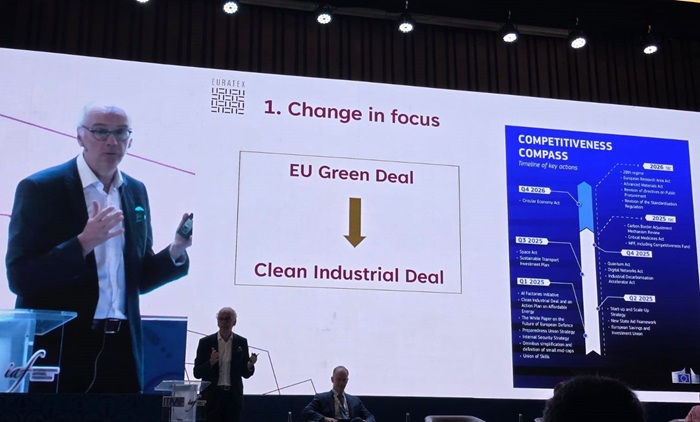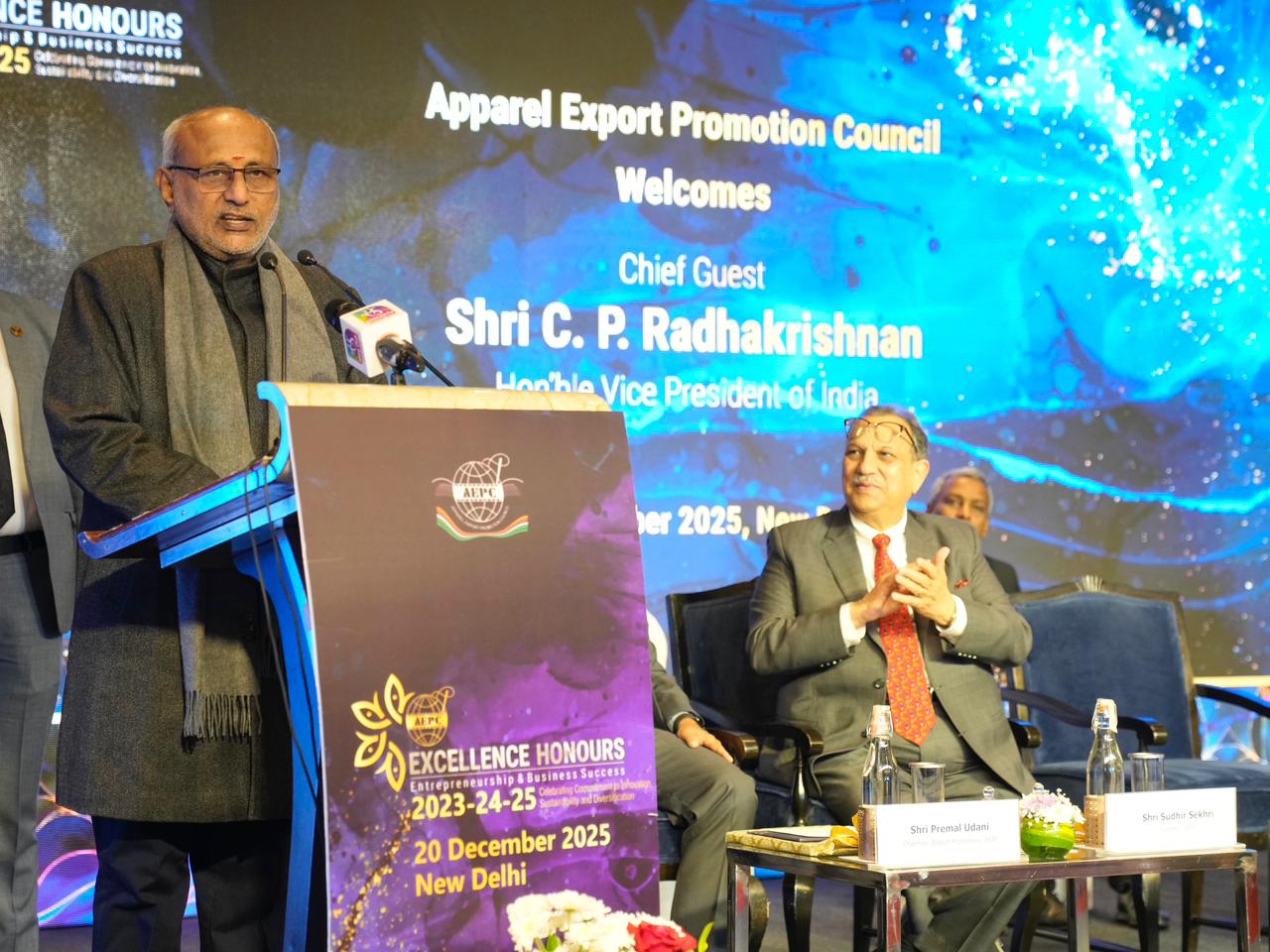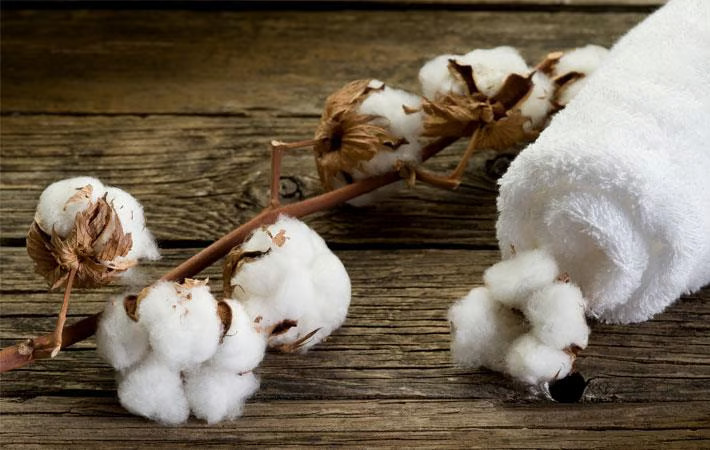FW
The Council of Fashion Designers of America (CFDA) and the Bezos Earth Fund have entered into a $6.25 million partnership to launch The Next Thread Initiative, a three-year program designed to accelerate innovation and education in sustainable fashion.
The initiative aims to support independent designers and emerging talent who are redefining how clothing is created, produced, and consumed. It will provide funding for designer awards, student scholarships, and storytelling projects intended to showcase the creative and commercial opportunities within sustainable fashion.
According to Steven Kolb, President and CEO, CFDA, this collaboration will equip designers and students with practical tools to help shape a more sustainable fashion industry. He specifically highlighted the instrumental leadership of Lauren Sánchez Bezos at the Bezos Earth Fund in turning ideas into action and fostering innovation. Kolb emphasized, the initiative aligns with the CFDA’s long-standing commitment to advancing sustainability in American fashion.
Those pioneering work in sustainable materials, circular design, and low-impact manufacturing will be eligible for grants ranging from $50,000 to $500,000.
Undergraduate and postgraduate students pursuing sustainable fashion design will receive scholarships between $25,000 and $75,000.
The CFDA plans to showcase the recipients' work through curated exhibitions, events, and digital storytelling campaigns to engage both industry professionals and the wider public.
Tom Taylor, Bezos Earth Fund President and CEO, noted, having reflected cultural shifts for long, the fashion industry now has the potential to become a catalyst for environmental change. In partnership with the CFDA Foundation, the Fund is investing in the next generation of designers and innovators who are shaping a more sustainable future for the industry, he noted.
Rocky Brands, Inc. (RCKY) delivered higher sales and improved profitability in Q3 FY25. Supported by a strong demand across its brand portfolio, the company’s net sales improved by 7.1 per cent Y-o-Y to $122.5 million.
Its net income soared by 36.6 per cent to $7.2 million, translating into a strong diluted Adjusted Earnings Per Share (EPS) of $1.03, which exceeded expectations.
The company’s gross margin expanded by 210 basis points to 40.2 per cent, primarily driven by successful full-price selling and favorable channel mix. Strategically, it saw growth across both its distribution channels, with wholesale sales rising by 6.1 per cent and retail (e-commerce) sales increasing by 10.3 per cent.
Looking forward, Rocky Brands is proactively increasing its inventory and leveraging its diversified sourcing, including facilities in the Dominican Republic and Puerto Rico, to manage costs and sustain momentum into 2026.
Falling under the Consumer Goods and Retail category, the global Organic Clothing market is projected to achieve a market size of $3.5 billion by 2031. The market is forecasted to grow at a CAGR of 10.5 per cent between 2025-31, building on an estimated $1.5 billion valuation in 2024. This highlights significant growth potential throughout the forecast period due to rising industrial adoption and continuous innovation in retail applications.
The Organic Clothing Market is currently experiencing robust expansion, primarily fueled by increasing consumer awareness regarding sustainable fashion and environmental impact. Rising demand for garments that are eco-friendly, chemical-free, and ethically produced is driving adoption across diverse demographics.
Manufacturers are actively innovating, using materials such as organic cotton, bamboo, hemp, and recycled fibers to enhance product comfort, durability, and style. Furthermore, the growing influence of social media, fashion influencers, and ‘green lifestyle’ trends is rapidly accelerating the acceptance of organic clothing worldwide.
By 2031, the Organic Clothing Market is expected to expand significantly as brands intensify their focus on transparency, supply chain sustainability, and certification standards.
To improve accessibility and consumer engagement, companies are integrating online retail channels, offering customization options, and launching limited edition collections. Demand is further boosted by the rising interest in slow fashion, eco-conscious gifting, and corporate sustainability initiatives. Continuous innovation in material sourcing, production processes, and eco-friendly packaging is positioning the market for long-term growth and widespread adoption globally.
The 5th China Chaoshan International Textile and Garment Exhibition (CTGE 2026) will be held on March 18, 2026, at the Shantou International Convention & Exhibition Center.
The exhibition will be organized across over 150,000 sq m - a significant jump from 130,000 sq m in its last edition. The event will showcase the latest technologies, products, and business models in the textile and apparel industry.
The exhibition will gather more than 1,200 enterprises from over 19 intimate apparel industrial clusters across China. For the first time, the event will feature a dedicated brand zone.
Over 50 activities are scheduled, including fashion shows, industry summits, youth entrepreneur forums, cultural festivals, and B2B matchmaking sessions, all emphasizing innovation and global collaboration.
Li Fei, Standing Committee Member, CPC Shantou Municipal Committee, underscored the city's commitment to strengthening its textile industry. Key infrastructure projects, such as the global textile procurement center, industrial park, and exhibition center, are already operational. Furthermore, new initiatives like an advanced fabric manufacturing base and an international digital trade hub are underway to cement Shantou's global influence in textiles and apparel.
Lin Yunfeng, President, China Knitting Industrial Association, praised CTGE 2026 as a crucial platform that connects domestic and international markets while driving industrial innovation. The exhibition has become a leading global event for intimate apparel, offering a successful ‘Chaoshan model’ for high-quality industry development, he noted.
Weng Chuangjie, Chairman, Shantou Textile and Garment Industry Association, highlighted the exhibition's rapid expansion and its role in helping local brands integrate into global supply chains.
CTGE 2026 will continue to foster industry collaboration through its ‘exhibition + fashion show + livestreaming + trade’ model, reinforcing Shantou's role as a key hub for intimate apparel worldwide.

The global apparel trade continues to reflect the delicate balance between recovery and restraint, as revealed in the October 2025 ‘Global Apparel Trade & Retail Update’ by Wazir Advisors. Despite signs of retail stability in the West, uneven import demand and a cooling export momentum across Asia underscore the complexities of post-pandemic consumption patterns and global sourcing realignments.
Import markets hold mixed fortunes
The apparel import data for August 2025 paints a fragmented picture of global consumer appetite. The US, traditionally the world’s largest apparel importer, saw inbound shipments fall to $7.7 billion, marking a 3 per cent year-on-year (YoY) decline. This drop signals a continuing inventory correction cycle among American retailers, who have been trimming orders amid cautious consumer spending and subdued apparel inflation.
In contrast, the European Union maintained a more stable path, with imports rising 1 per cent YoY to $9.1 billion, driven by stronger performance in southern and eastern European markets. Retailers in Spain, Italy, and Poland reported steady sell-through rates, aided by rising domestic fashion production and renewed consumer confidence in mid-tier brands.
Japan, often considered a barometer of mature fashion markets, mirrored this marginal growth with imports touching $2.2 billion, up 1 per cent YoY. The country’s aging demographic and shift toward sustainable and functional fashion categories such as lightweight outdoor wear and home-living apparel continue to redefine its sourcing patterns, with increasing focus on Vietnam and Indonesia.
The standout performer, however, was the UK, where apparel imports rose 17 per cent YoY to $2.2 billion. This sharp rise is linked to the rebound of high-street retail and the ongoing influence of digital-native fashion labels. The UK’s import acceleration also indicates pre-winter inventory buildup and improved port logistics after months of supply disruptions.
Asian exporters face issues as global demand evens out
On the export front, the September 2025 data highlights persistent headwinds for major Asian suppliers. China’s apparel exports, while still the world’s largest at $12.0 billion, recorded an 8 per cent YoY decline, continuing its gradual downtrend as Western buyers diversify sourcing bases. Rising domestic labor costs, coupled with lingering US trade pressures and sustainability compliance costs, have eroded China’s cost advantage in basic garment categories.
Bangladesh, the world’s second-largest apparel exporter, reported shipments worth $2.8 billion, down 7 per cent YoY. While its country’s knitwear segment remains strong woven garment orders particularly from the US and Germany have slowed. Buyers are tightening lead times and increasingly demanding traceability certifications, posing challenges for mid-sized factories that are yet to digitize their operations.
India, despite its growing reputation for value-added fashion and cotton-based products, faced one of the sharper declines, with exports dropping 10 per cent YoY to $1 billion. The slowdown is attributed to lower demand from the EU and the US, along with raw material price volatility. However, industry analysts expect a rebound in the final quarter of FY26, as festive-season shipments and sustainability-linked orders pick up.
Vietnam emerged as the only bright spot among the top Asian exporters, with exports up 3 per cent YoY to $3.9 billion (as of July 2025). Vietnam’s steady growth underscores its competitive advantage in flexible manufacturing, stable policies, and preferential trade access through multiple free trade agreements (FTAs), particularly with the EU and CPTPP partners.
The Shifting Dynamics: From volume to value
A closer look at these numbers reflects a deeper structural shift in global fashion trade, from volume-led growth to value-driven resilience. Western retailers are no longer chasing low-cost bulk sourcing; instead, they are prioritizing speed, traceability, and nearshoring. This is prompting Asian producers to recalibrate their export strategies, investing in automation, recycled fibers, and digital compliance systems.
According to Wazir Advisors, retailers in major markets are likely to favor agile sourcing ecosystems that can balance cost efficiency with transparent production practices. This trend benefits countries like Vietnam and Turkey, which offer vertically integrated setups and quicker turnaround times compared to traditional export powerhouses.
Retail outlook is stabilization, not expansion
The broader implication of Wazir’s October 2025 report is that the global apparel sector is in a stabilizing phase rather than a recovery sprint. Retailers are focusing on inventory normalization, while suppliers are navigating price-sensitive yet sustainability-aware buyers. Analysts suggest that unless new trade agreements or fiscal stimuli reinvigorate consumer demand in the US and EU, the next two quarters will likely remain moderate in growth. However, as energy prices stabilize and inflationary pressures ease, apparel trade could regain momentum heading into 2026, albeit at a slower, more balanced pace.
Navigating the new normal of global fashion trade
The October 2025 ‘Global Apparel Trade & Retail Update’ reaffirms that the industry is transitioning into a new normal where agility and transparency outweigh pure scale. While short-term challenges persist, the long-term fundamentals of apparel trade remain intact, supported by evolving consumer preferences, technology-led efficiency, and sustainable material innovations. For exporters across Asia and retailers in the West alike, the key question is no longer about ‘how much’ to trade, but ‘how responsibly’ and ‘how quickly’ they can deliver fashion in a world recalibrating its consumption ethos.
EURATEX Director General pitches "New Business Model" at textile conference at Yogyakarta, Indonesia

The global textile and apparel value chain is at a critical juncture, requiring a fundamental shift in its operating philosophy. This was the core message delivered by Dirk Vantyghem, Director General of the European Apparel and Textile Confederation (EURATEX), during his presentation at the recent joint conference by the International Textile Manufacturers Federation (ITMF) and the International Apparel Federation (IAF) in Yogyakarta, Indonesia.
Vantyghem’s address, which outlined EURATEX's perspective, introduced a "new business model" as a vital guide for the industry through its current turbulent period of economic volatility and intense regulatory change.
The five pillars of change
The presentation highlighted five key takeaways that underscore the necessity for this new model, moving beyond traditional production-focused paradigms:
1. Fragile sustainability business case: Despite widespread industry investment in sustainability initiatives, the commercial viability is often undermined by global over-capacities in virgin fibres and garments, driving prices unsustainably low. Vantyghem stressed that a 'smart regulatory framework' is essential, one that is properly controlled and globally implemented to level the playing field.
2. Regulatory harmony is crucial: To avoid inefficiency and competitive distortion, the Director General called for urgent regulatory dialogue and convergence. He pointed to inconsistencies, such as the potential for two parallel Digital Product Passports (DPPs) and different definitions of textile waste, as major roadblocks. The post-conference fringes reportedly saw some positive movement on this front.
3. Fair Trade over Free Trade: While EURATEX remains committed to open markets, the call was strong for trade to be fair and reciprocal. Vantyghem argued that existing free trade agreements must be re-evaluated and re-balanced to ensure a level playing field for European manufacturers.
4. The 'Ecosystem' approach: A recurring theme across the entire conference, noted by Vantyghem, was the overwhelming consensus on the need for an "ecosystem" approach—working in broader partnerships across the value chain. Achieving this, however, requires a significant shift in existing business mentality.
5. Direct dialogue with Consumers: A strong call was made for manufacturers to engage in more direct dialogue and storytelling with the consumer. This strategy aims to reduce dependency on major brands' images and allow companies' efforts in innovation and sustainability to be directly recognised.
A renewed focus for Europe
Sharing the stage with global textile experts, Vantyghem acknowledged that the conference provided a vital perspective on the challenges facing the European industry.
The final message was clear: European manufacturers must respond to global pressures by investing in innovation, high quality, and niche products. While remaining vigilant about threats from global competition and market turbulence, the continent's industry must maintain confidence in its core strengths of advanced technology and high-value production.
H&M Move has launched its most elevated ski collection, blending high-fashion aesthetics with technical performance for the slopes and après-ski.
The collection was developed in partnership with the renowned ski design experts at Grand Studio. A few of its select garments include built-in Recco reflections, a rescue technology that makes wearers searchable by professional rescue teams in case of an avalanche or if they get lost. The collection utilizes H&M Move's trademarked performance fabrics including StormMove, which is dsigned to be windproof, waterproof, and breathable; ThermoMove, a fabric engineered for heat-retention to provide warmth and Fleece SoftMove, used for comfortable layers.
The garment pieces in the collection feature practical elements like snow gaiters, goggle wipes, and ski pass pockets. The range offers a full system of gear, including technical outerwear (jackets and pants), bold ski suits and one-pieces, 2-layer and 3-layer shell jackets, 100 per cent Merino base layers and accessories like embellished goggles and furry leg warmers.
The collection embraces a sophisticated palette of deep aubergine purple, rich coffee bean brown, pale burgundy, and creamy neutrals.Its designs showcase bold, sculptural shapes and clean lines. A few of the notable items in this collection include a workwear-inspired ski set, a quilted jacket with a sculptural collar, and a metallic-studded ski jacket.
The offers pieces that transition seamlessly from the slopes to the chalet, including items like a faux leather-inspired ski suit and snug, quilted liners.
The collection offers ranges for Women, Men, and Kids (often with ‘Mini-Me’ versions offering full mountain-ready functionality.
Gildan Activewear registered a 2.2 per cent Y-o-Y growth in net sales to $911 million in Q3, FY25. This was in line with their low single-digit growth guidance.
Their adjusted diluted EPS rose significantly by 17.6 per cent to a record $1.00, beating market expectations. Adjusted operating margin reached a record high of 23.2 per cent, an 80 basis point improvement, primarily driven by lower manufacturing costs and favorable pricing.
The company’s gross margins improved by 250 basis points to 33.7 per cent of net sales, mainly due to lower manufacturing costs and favorable pricing.
Crocs, Inc reported a 6.2 per cent Y-o-Y decline in consolidated revenues to $996 million in Q3, FY25.
This overall drop was largely driven by a significant slowdown in the HeyDude brand, whose revenues plummeted by 21.6 per cent to $160 million. The weakening of the HeyDude brand was primarily concentrated in the wholesale channel, which saw a steep decrease of 38.6 per cent, though its direct-to-consumer (DTC) revenues only dipped slightly by 0.5 per cent.
The flagship Crocs brand also contributed to the overall revenue slump, with sales decreasing by 2.5 per cent to $836 million, particularly with an 8.8 per cent decline in the North American region.
The company's overall wholesale revenues across both brands decreased by a sharp 14.7 per cent, in contrast to a modest 1.6 per cent growth in its DTC channel. Crocs' cited cautious consumer spending, particularly among lower-income consumers, and increased competition from athletic brands as factors impacting performance. Looking ahead, the company has projected a continued revenue decline in Q4, FY25, anticipating an approximate 8 per cent decline with HeyDude sales expected to fall by a further mid-20 per cent.
Cotton production in India is forecast to reach 25 million 480-lb bales, cultivated across approximately 11.4 million hectare with an average yield of 477 kg per hectare.
Government initiatives have further strengthened the industry’s growth. The Pradhan Mantri Mega Integrated Textile Region and Apparel Parks Scheme aims to create seven world-class textile parks equipped with modern infrastructure and integrated value chains.
Notably, the first park in Madhya Pradesh has already attracted Rs 20,746 crore in investments, positioning it as India’s largest textile hub. Additionally, the temporary suspension of the 11 per cent import duty on cotton, effective from August 19 to September 30, 2025, is expected to support












